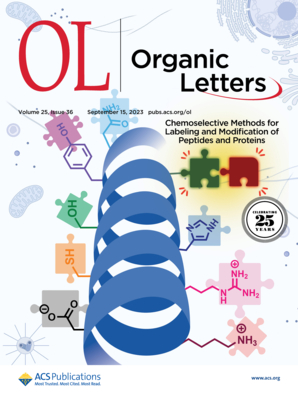超越Friedel-Crafts: 2-(三烷基硅基)吡啶的自发和氟催化酰化
IF 5
1区 化学
Q1 CHEMISTRY, ORGANIC
引用次数: 0
摘要
2-(三烷基硅基)吡啶与酰基氯化物自发反应,产率高,生成2-吡啶酮。该过程包括n -酰化、脱硅化、c -酰化和n -去酰化四个基本步骤,并导致羰基选择性单取代。该反应机制的关键步骤是产生稳定的酰体(汉米克中间体),它起亲核试剂的作用。对于复杂分子的功能化,已经开发了一种利用更稳定的酰基氟化物的替代氟化物催化方案。本文章由计算机程序翻译,如有差异,请以英文原文为准。

Beyond Friedel–Crafts: Spontaneous and Fluoride-Catalyzed Acylation of 2-(Trialkylsilyl)pyridines
2-(Trialkylsilyl)pyridines react spontaneously with acyl chlorides to give 2-pyridyl ketones in high yields. The process consists of four elementary steps of N-acylation, desilylation, C-acylation, and N-deacylation and results in a selective monosubstitution at the carbonyl group. The key step in this mechanism is the intrinsic generation of a stabilized ylide (Hammick intermediate), which acts as a nucleophile. For the functionalization of complex molecules, an alternative fluoride-catalyzed protocol utilizing more stable acyl fluorides has been developed.
求助全文
通过发布文献求助,成功后即可免费获取论文全文。
去求助
来源期刊

Organic Letters
化学-有机化学
CiteScore
9.30
自引率
11.50%
发文量
1607
审稿时长
1.5 months
期刊介绍:
Organic Letters invites original reports of fundamental research in all branches of the theory and practice of organic, physical organic, organometallic,medicinal, and bioorganic chemistry. Organic Letters provides rapid disclosure of the key elements of significant studies that are of interest to a large portion of the organic community. In selecting manuscripts for publication, the Editors place emphasis on the originality, quality and wide interest of the work. Authors should provide enough background information to place the new disclosure in context and to justify the rapid publication format. Back-to-back Letters will be considered. Full details should be reserved for an Article, which should appear in due course.
 求助内容:
求助内容: 应助结果提醒方式:
应助结果提醒方式:


